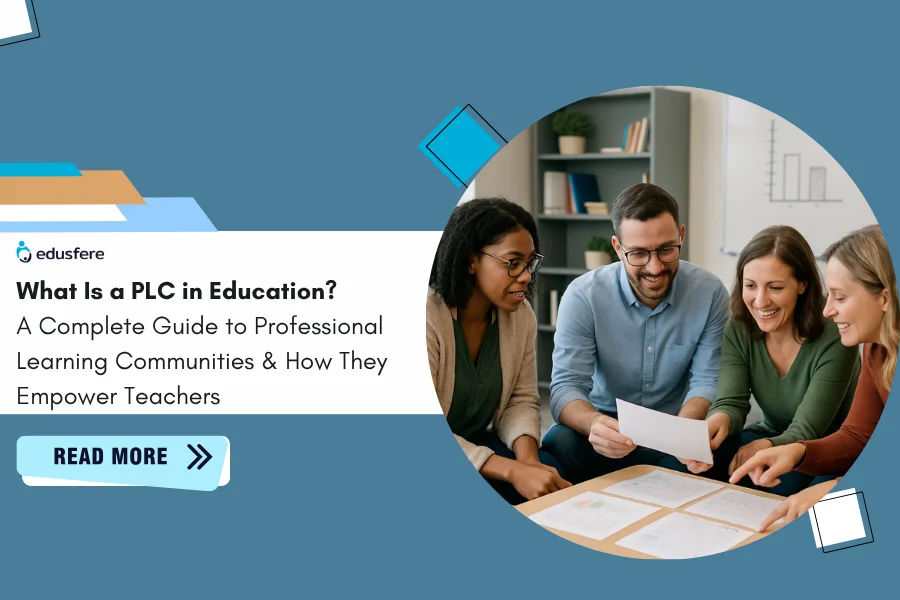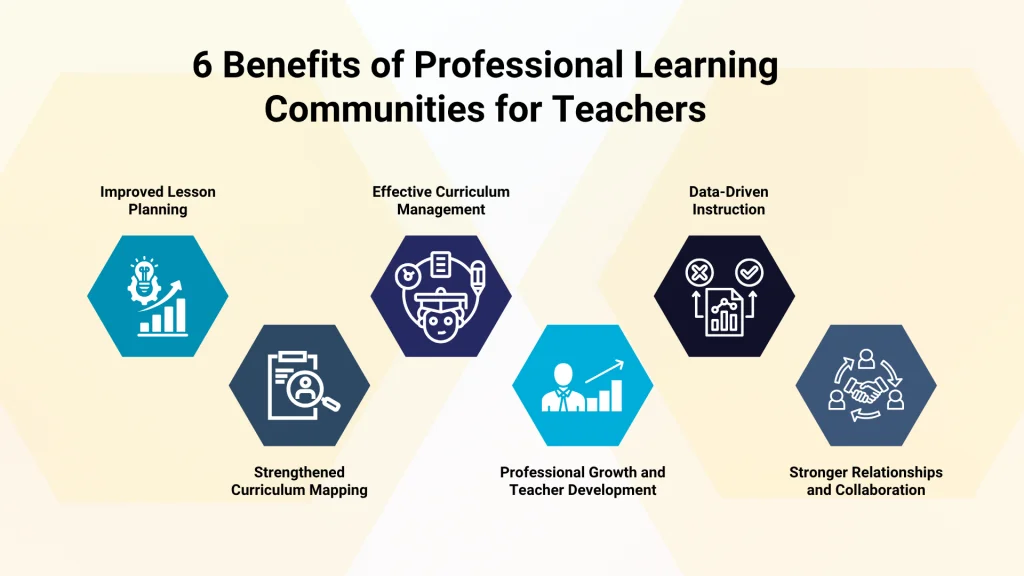Schedule a free demo to learn more
What is a PLC in Education? A Complete Guide to Professional Learning Communities & How They Empower Teachers
13Oct 2025

Every teacher can resonate with the feeling of standing in front of a classroom, trying new strategies, wondering if there’s a better way to reach that one student who still seems lost. Teaching is as much about reflection and collaboration as it is about content and curriculum. But for years, teachers worked in isolation, separated by classroom walls and busy schedules.
Then came a quiet revolution in schools around the world with the rise of Professional Learning Communities (PLCs). These communities have reshaped how educators grow, plan and problem-solve together.
So, what is a PLC in education exactly? How do they work, and why are they considered one of the most effective ways to boost both teaching quality and student learning?
Let’s unpack the concept in detail, answer every question teachers and school leaders often ask and explore how PLCs can become the heartbeat of a thriving school culture.
What is a PLC in Education?
To begin with, understanding the meaning and definition of Professional Learning Communities is indispensable. At its simplest, a Professional Learning Community (PLC) is a group of educators who meet regularly to share expertise, reflect on teaching practices and focus on improving student outcomes.
But that definition doesn’t capture the magic that happens inside a PLC. It’s not just another meeting or a “workshop.” A PLC is a mindset, a belief that when teachers learn together, students learn better.
PLC Education Definition
A PLC in education refers to a structured system of collaboration where teachers continually analyze data, share best practices and take collective responsibility for the success of all students. This means moving away from the idea that “my students” are only the 30 in my classroom ; and embracing that every student in the school is “our” student.
PLC Education Meaning in Everyday Terms
Think of a PLC as a teacher support ecosystem. It’s where colleagues come together to ask:
- What do we want students to learn?
- How will we know if they’ve learned it?
- What will we do if they haven’t?
- What can we do if they already have?
By asking these questions collaboratively and not in isolation, teachers transform from individual practitioners into collective problem-solvers.
Why do we need PLCs in Education?
Teaching is one of the few professions where you spend most of your day surrounded by people and yet, it can feel incredibly lonely. Teachers juggle planning, grading and emotional support for students, often without structured time to share challenges or celebrate wins. This isolation is exactly what PLCs aim to eliminate.
Key Reasons PLCs are Essential
- Breaking Teacher Isolation: Teachers get to collaborate, observe and learn from one another’s experiences.
- Creating Consistency: PLCs ensure students across different classes or grade levels receive a consistent learning experience.
- Making Professional Development meaningful: Instead of one-off training sessions, PLCs offer ongoing, job-embedded learning.
- Improving Student Results: Every conversation in a PLC revolves around what improves student understanding and achievement.
- Building a Culture of Trust and Growth: When teachers collaborate regularly, trust grows, feedback improves, and innovation becomes natural.
PLCs aren’t just about teacher meetings. They’re about transforming school culture into one that thrives on shared goals and collective accountability.
How Do PLCs Work?
A successful PLC doesn’t happen by chance. It’s designed intentionally around a few core principles that make collaboration meaningful and sustainable.
1. Shared Vision and Mission
Every PLC begins with a common goal: improving student learning. Teachers define what success looks like and align their teaching practices toward that vision.
For example, a PLC might focus on “improving reading fluency in Grade 3” or “enhancing critical thinking in science.” These shared missions give every meeting purpose and direction.
2. Collaborative Teams
PLCs work best in small groups, usually 3 to 8 teachers who teach similar subjects or grade levels. These teams meet weekly or biweekly to discuss student progress, share teaching strategies and solve classroom challenges together.
3. Inquiry-Based Learning
A key concept in PLCs is inquiry encompassing the practice of asking questions and investigating solutions rather than simply sharing opinions. Teachers might examine student work, test new instructional methods and reflect on what worked and what didn’t.
4. Data-driven Decision Making
In a PLC, data isn’t about numbers, it’s about insights. Teachers use formative assessments, student feedback and performance data to understand where students struggle and how instruction can improve.
5. Action & Reflection
Each PLC follows a cycle of continuous improvement:
Plan → Do → Study → Act
Teams plan a strategy, try it in the classroom, analyze the results and adjust. This turns theory into practice and makes learning dynamic.
What are the benefits of PLCs in Education?

PLCs have transformed how educators grow. Here are six powerful benefits teachers and schools experience when PLCs are done right.
1. Improved Student Achievement
When teachers regularly analyze student work and adapt lessons based on data, learning gaps shrink faster. PLCs help identify struggling students early and ensure no one slips through the cracks.
2. Stronger Teacher Collaboration
Instead of working alone, teachers become part of a supportive professional family. They co-create lesson plans, exchange ideas and learn from one another’s successes and mistakes.
3. Consistent Instruction Across Classrooms
When teachers share best practices, schools achieve greater consistency. Students receive a coherent learning experience whether they’re in Class 4A or 4C.
4. Continuous Professional Growth
Unlike traditional PD workshops that fade after a day, PLCs provide ongoing, embedded learning. Every week becomes a new opportunity to learn and grow as an educator.
5. Better use of data
Teachers in PLCs move beyond intuition. They make instructional decisions based on real evidence. This empowers them to intervene early and personalize learning effectively.
6. Higher Morale & Teacher Retention
When teachers feel valued, supported and part of a mission-driven team, their enthusiasm for teaching skyrockets. Schools with strong PLCs often report lower burnout and turnover rates.
What challenges do PLCs face?
Even the best ideas can falter without the right foundation. PLCs can struggle if they lack time, structure or leadership support. Some of the common challenges PLCs often face include:
Time constraints: Teachers already have full schedules. Without protected time, PLCs become rushed or inconsistent.
Lack of focus: Meetings can drift into general discussions instead of targeted analysis.
Weak facilitation: Without clear norms or trained leaders, conversations can lose depth.
Limited access to data: Without meaningful data, reflection becomes guesswork.
Resistance to change: Some educators may view PLCs as ‘extra work’ rather than part of their professional growth.
How to overcome the challenges faced by PLCs
- Secure administrative support for scheduled PLC time.
- Train teacher facilitators and provide structured protocols for meetings.
- Keep goals specific and measurable.
- Use common assessments and data dashboards.
- Celebrate small wins; momentum builds motivation.
How to start a PLC in your School
Here’s a step-by-step guide to building a thriving Professional Learning Community or PLC in your school:
- Define your vision: Clarify your purpose and desired outcomes.
- Form small collaborative teams: Group teachers by subject or grade.
- Create norms & protocols: Agree on how meetings will run and how decisions will be made.
- Set SMART Goals: Make them specific, measurable, achievable, relevant and time-bound.
- Collect and Analyze Data: Use formative assessments and student feedback.
- Reflect and Adjust: Regularly review progress and refine strategies.
- Celebrate Successes: Recognize teachers’ efforts and student progress.
Building a PLC takes time but once it’s part of your school culture, it becomes a self-sustaining engine for growth.
Measuring the impact of PLCs
The best PLCs produce visible results, not just in student performance but also in teacher engagement and school culture.
Indicators of Effective PLCs include:
- Improved student learning outcomes and growth rates
- Higher teacher satisfaction and retention
- Increased instructional consistency
- Clear, documented cycles of inquiry and reflection
- More collaboration across grades or subjects
Frequently Asked Questions About PLCs
Q: Is a PLC just another name for staff meetings?
No, PLCs are structured, inquiry-driven and data-focused. Staff meetings are often logistical, whereas PLCs are professional growth hubs.
Q: How often should PLCs meet?
Ideally weekly or biweekly for 45-90 minutes. The key is regularity and focus.
Q: Can PLCs work online?
Absolutely! Virtual PLCs using platforms like Google Meet or Microsoft Teams are effective when structured well.
Q: Who should lead a PLC?
Teacher leaders or instructional coaches often facilitate PLCs, supported by principals who protect time and resources.
Why PLCs are the future of education
The world of education is changing faster than ever with new technologies, diverse classrooms and shifting expectations challenge teachers daily. But one truth remains constant and that is, teachers grow best when they learn together.
PLCs remind us that education is not a solo act; it’s a team effort. They transform schools into communities where learning never stops, both for students and teachers.
Edusfere’s Note to Educators
At Edusfere, we believe collaboration is the cornerstone of great teaching. Our mission is to empower teachers and school leaders with tools, insights and resources to build thriving Professional Learning Communities that truly make a difference.
Ready to start your PLC journey?
Explore our free resources, downloadable templates and step-by-step guides. Together, let’s turn every classroom into a connected, inspired learning community.